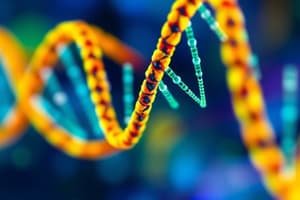Podcast
Questions and Answers
What is the primary purpose of using machine learning in genomics?
What is the primary purpose of using machine learning in genomics?
- To eliminate human intervention
- To improve understanding of hidden patterns in large genomics data sets (correct)
- To directly edit genes
- To reduce the size of genetic data
Deep learning is a subset of machine learning that does not require human input.
Deep learning is a subset of machine learning that does not require human input.
True (A)
What is the complete set of DNA in a human known as?
What is the complete set of DNA in a human known as?
The human genome
The human genome consists of over ______ genes.
The human genome consists of over ______ genes.
Match the following machine learning types with their definitions:
Match the following machine learning types with their definitions:
How many base pairs of DNA are approximately in the human genome?
How many base pairs of DNA are approximately in the human genome?
All human cells contain a complete copy of the genome.
All human cells contain a complete copy of the genome.
What capability do machines gain through machine learning?
What capability do machines gain through machine learning?
What are the four nitrogenous bases that make up DNA?
What are the four nitrogenous bases that make up DNA?
All regions of the human genome code for proteins.
All regions of the human genome code for proteins.
What was the primary aim of the Human Genome Project?
What was the primary aim of the Human Genome Project?
The process by which organisms can adapt to their environments over time is known as ___ .
The process by which organisms can adapt to their environments over time is known as ___ .
Match the following terms with their descriptions:
Match the following terms with their descriptions:
Which of the following is a key outcome of the Human Genome Project?
Which of the following is a key outcome of the Human Genome Project?
The human genome consists of 46 chromosomes organized in 23 pairs.
The human genome consists of 46 chromosomes organized in 23 pairs.
What role do genes play in determining an individual's traits?
What role do genes play in determining an individual's traits?
What is the role of CRISPR in genomic research?
What is the role of CRISPR in genomic research?
AI has no significant contribution to the field of genomics.
AI has no significant contribution to the field of genomics.
What is precision medicine?
What is precision medicine?
AI techniques help model target proteins and predict drug effects based on __________ data.
AI techniques help model target proteins and predict drug effects based on __________ data.
What is a major concern regarding genomic data?
What is a major concern regarding genomic data?
Match the following AI contributions with their descriptions:
Match the following AI contributions with their descriptions:
As of 2021, genomic research is expected to generate between 2 and 40 gigabytes of data annually.
As of 2021, genomic research is expected to generate between 2 and 40 gigabytes of data annually.
The human genome contains approximately __________ base pairs.
The human genome contains approximately __________ base pairs.
Flashcards
Machine Learning
Machine Learning
A field of study within AI that enables machines to learn from data without explicit programming.
Supervised Learning
Supervised Learning
A type of machine learning where machines are given labeled data to learn from, allowing them to identify patterns and make predictions.
Unsupervised Learning
Unsupervised Learning
A type of machine learning where machines learn from unlabeled data, discovering patterns and insights without human intervention.
Deep Learning
Deep Learning
Signup and view all the flashcards
Artificial Neural Network
Artificial Neural Network
Signup and view all the flashcards
Human Genome
Human Genome
Signup and view all the flashcards
Base Pairs
Base Pairs
Signup and view all the flashcards
Genes
Genes
Signup and view all the flashcards
Genome
Genome
Signup and view all the flashcards
Chromosome
Chromosome
Signup and view all the flashcards
DNA
DNA
Signup and view all the flashcards
Nitrogenous bases
Nitrogenous bases
Signup and view all the flashcards
Heredity
Heredity
Signup and view all the flashcards
Human Genome Project (HGP)
Human Genome Project (HGP)
Signup and view all the flashcards
Personalized Medicine
Personalized Medicine
Signup and view all the flashcards
Ethical and Privacy Concerns in Genomics
Ethical and Privacy Concerns in Genomics
Signup and view all the flashcards
Gene Editing
Gene Editing
Signup and view all the flashcards
Gene Sequencing
Gene Sequencing
Signup and view all the flashcards
AI for Big Data Analysis in Genomics
AI for Big Data Analysis in Genomics
Signup and view all the flashcards
AI for Personalized Diagnosis
AI for Personalized Diagnosis
Signup and view all the flashcards
AI for Drug Discovery
AI for Drug Discovery
Signup and view all the flashcards
Why is AI Needed in Genomics?
Why is AI Needed in Genomics?
Signup and view all the flashcards
Study Notes
Artificial Intelligence, Machine Learning, and Genomics
- Genomics research utilizes computational methods like AI and machine learning to analyze complex genomic datasets, improving our understanding of hidden patterns in both basic and clinical research.
Machine Learning and Deep Learning
- Machine learning (ML) and deep learning (DL) are subfields of artificial intelligence (AI).
- ML enables machines to learn from data without explicit programming.
- Supervised learning involves training data with predefined categories, enabling the machine to predict outcomes for new data.
- Unsupervised learning requires no pre-defined categories, allowing machines to identify patterns on their own.
- Deep learning is a modern ML technique, enabling more complex pattern recognition.
Gene Editing and Deep Learning
- Deep learning algorithms analyze complex data sets.
- These algorithms imitate how neural networks in the human brain operate.
- They analyze data importance.
- They understand and manage logical biases in the data.
Human Genome
- The human genome is the complete DNA set in a human, containing the genetic information for growth, development, and functioning.
- It consists of over 20,000 genes and around 3 billion base pairs.
- Each human cell holds a full copy of the genome.
- DNA is a double helix structure with four bases: adenine (A), thymine (T), cytosine (C), and guanine (G).
- Genes provide instructions for protein production, playing essential roles in various bodily functions and traits.
- Most human genome is non-coding, playing crucial roles in gene regulation and chromosome structure
The Human Genome Project (HGP)
- The HGP mapped the entire human genome in 2003.
- This project brought profound impacts on medical, biological research and understanding of human evolution.
- Key outcomes include understanding genetic disorders like cystic fibrosis and cancers, and personalizing treatments tailored to an individual's genetic makeup.
Significance of Studying the Human Genome
- Genomic research significantly advances our understanding of genetic diseases and aids in their diagnosis and treatment.
- It provides insights into human evolution and our relationship with other species.
Modern Genomic Technologies
- Advanced gene sequencing technologies enable quick- and accurate DNA decoding.
- Gene editing tools like CRISPR allow the modification of specific genes.
AI/ML in Genomics (Contribution)
- AI contributes to genome research by enabling big data analysis.
- AI-based machine learning algorithms identify patterns within complex genomic data sets, contributing to early diagnosis of diseases.
- AI helps in personalized diagnosis and treatment.
- AI techniques aid in drug discovery by modeling target proteins and predicting drug effects based on genomic data, reducing development time and costs.
Why is there a need for AI/ML in Genomics?
- The completion of the human genome sequence led to an extraordinary amount of genomic data.
- DNA sequencing techniques continue to increase the volume and complexity of genomic data.
- AI/ML are necessary for handling and interpreting the complex data to extract valuable insights.
How AI/ML is Used in Genomics
- AI programs accurately identify genetic disorders using facial analysis.
- Machine learning techniques identify the primary kind of cancer from a liquid biopsy.
- AI helps predict the progression of cancer in patients.
- Machine learning is used to identify disease-causing or benign genomic variants.
- Deep learning helps improve gene editing techniques (e.g.,CRISPR).
- AI predicts future variations in genomes for public health efforts.
Studying That Suits You
Use AI to generate personalized quizzes and flashcards to suit your learning preferences.
Related Documents
Description
This quiz explores the intersection of artificial intelligence, machine learning, and genomics. It covers how computational methods aid in analyzing genomic data and recognizes different learning strategies in machine learning and deep learning. Test your understanding of these advanced technologies in genomic research.




